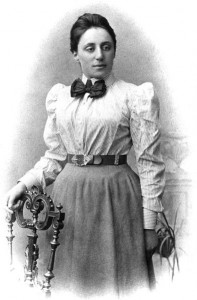
Emmy Noether. Image from Wikipedia.
It was Emmy Noether’s intent to teach French and English, but instead she chose to audit math classes at the University of Erlangen in Germany (where her father was a mathematics professor). She earned her Ph.D in 1907, and spent the next seven years teaching at the Mathematical Institute of Erlangen without pay, as most women were denied academic positions. She then joined the mathematics faculty at the University of Gattingen, though for her first four years she lectured under the name of a male colleague, as the philosophy faculty objected to a woman lecturing to the largely male student body.
Despite these attempts to stifle her work, Emmy’s expertise in math and physics had become widely known, and people came from far and wide to study with her. These dedicated students were known as “Noether’s boys,” and many of them went on to become great mathematicians themselves.
Emmy’s work spanned a variety of fields, including theoretical physics and dynamic systems. Noether’s theorem’s it quickly became known – alongside Einstein’s theory of relativity, underpins much of modern physics. In mathematics, she is best known for her work in algebra and topology (the study of shapes).
As hostility toward Jews grew during World War II, Emmy eventually lost her teaching position and decided to leave Germany. She took up a position at Bryn Mawr in Pennsylvania, where, for the first time, she was surrounded by female academics. At Bryn Mawr, Emmy finally felt appreciated in a way she never had in Germany. Sadly, her time in the US was short-lived, as she died a few days after undergoing surgery to remove an ovarian cyst. In the days and weeks after she died, tributes to Emmy and her work came in from around the world, including from former colleagues in Germany and Albert Einstein.
